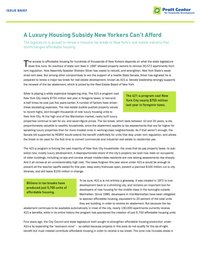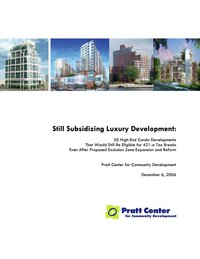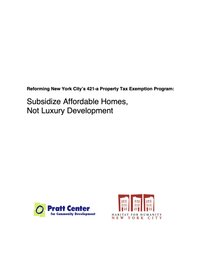From 2003–2008, Pratt Center played a pivotal role in reforming New York City’s 421-a tax abatement to expand the program’s reach and sponsor the creation of affordable housing beyond central Manhattan.
Pratt Center issued a series of reports describing how the program was being used to subsidize market rate and luxury housing rather than the affordable housing it was designed to generate.
Former director Brad Lander, now the City Comptroller, served on a mayoral task force evaluating options for reform of the program, which in 2006 cost New York City $400 million even while many developers receiving the benefit were not obligated to produce affordable housing in exchange.
As a result of a successful campaign on which the Pratt Center worked closely with ACORN, Habitat for Humanity, Housing Here and Now, Queens for Affordable Housing and others to campaign for reform, the “exclusion zone”— in which developers seeking the tax benefit must provide affordable housing—expanded into parts of all five boroughs. These 2008 reforms also for the first time required all affordable housing to:
- be built on the same sites as market-rate units (previously, they could be located elsewhere);
- give community residents preference in the application process for half of all units initially offered for rent or sale;
- require rent stabilization for a minimum of 35 years; and
- pay prevailing wages to building workers.
About 421-a
New York City’s 421-a property tax exemption program was created in the 1970s, when the city was on hard times, to encourage developers to build new housing. In the 1980s, it was adjusted to help encourage affordable housing—so buildings in Manhattan (roughly between 14th & 96th Streets, known as the “exclusion zone”) have to include 20% affordable units in order to receive a tax break. But elsewhere in the city, developers receive a 10–15 year “as-of-right” tax break for any new, market-rate, multifamily development. As a result, exclusively high-end buildings in every corner of the city are receiving large tax exemptions.
In 2006, the City gave $400 million in tax breaks through the 421-a program, with most of that going to subsidize luxury development. In the fall of that year, a task force appointed by Mayor Michael Bloomberg proposed to adjust the program: to expand the “exclusion zone” (where affordable housing is required in exchange for the tax break) to cap the benefits that buildings outside of that zone can receive, and to eliminate the inefficient off-site “negotiable certificates” program.
However, in many neighborhoods in all five boroughs, exclusively market-rate developments—even million-dollar condos—would still receive tax breaks (of up to approximately $107,000 per unit in lifetime benefits). That meant a 50-unit luxury building could receive $5.3 million in lifetime tax breaks. Essentially, moderate and middle income New Yorkers were paying more in taxes to give a tax break to developers and condo-buyers.
A Luxury Housing Subsidy New Yorker’s Can’t Afford (2011)
This issue brief from the Pratt Center details the cost of the 421-a abatement to New York City and recommends measures to better target the benefit to generate affordable housing and transit-oriented development. It was issued in June 2011 as the state legislature was poised to revive the tax break in exchange for the renewal of rent regulation, which was set to expire June 15. As Albany trades 421-a renewal for the rent laws that protect the access to affordable housing of more than 1 million tenants in New York City alone, it is critical to understand the actual value of the tax abatement to developers and the ways in which the program was constructed gave out its benefits indiscriminately, in most cases without leveraging anything in exchange.
Still Subsidizing Luxury Development (2006)
This 2006 report calls for the reform of New York City’s 421-a tax exemption program to stop giving tax breaks to building owners who do not include affordable housing units. It highlights 54 condo buildings—built in the last few years or currently under construction—that would still be eligible for 421-a tax relief, even if they would have been built after the reforms proposed at the time by the Speaker and the Mayor.
Reforming New York City’s 421-a Property Tax Exemption Program (2003)
In this report published in July 2003, Habitat for Humanity-New York City and Pratt Center for Community Development review the 421-a property tax exemption program and present findings that the program is being used to subsidize market rate and luxury housing rather than the affordable housing it was designed to generate.


